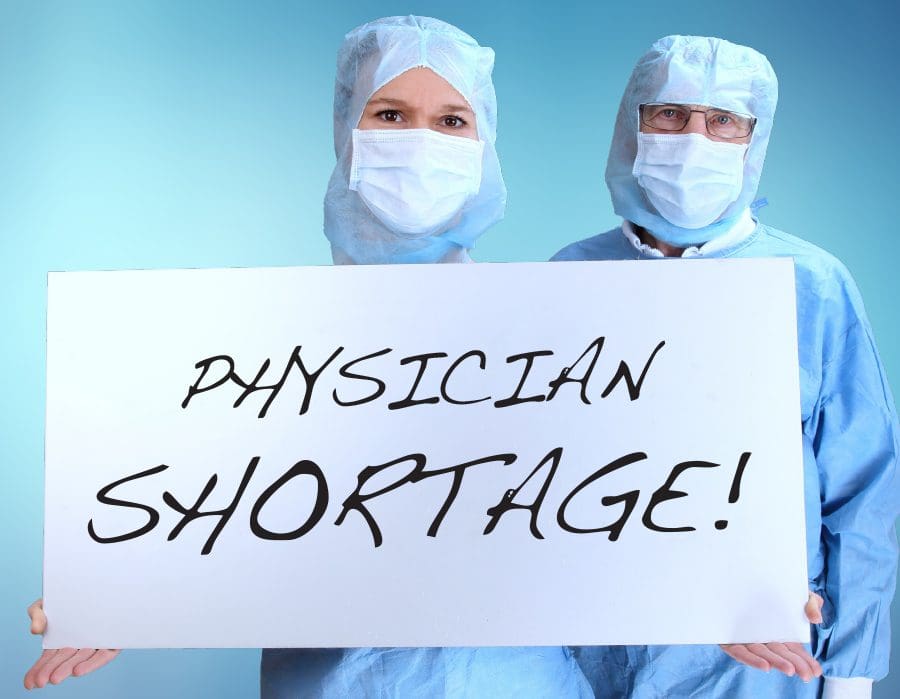
By DR. Richard Bosshardt
Long wait times to see a doctor? Here is why.


The doctor cannot see you now.
My wife’s primary care provider (PCP) recently retired. In March, she was having some issues and tried to get in to see one of his more established partners. The first available was in August! She was finally able to see one of the newest doctors in the practice, and even that appointment was a month away. Fortunately, her problem, although uncomfortable, was minor.
I have a physician friend a few years younger than me who is nearing his one-year anniversary of a bone marrow transplant for leukemia, a huge milestone as it means his risk of relapse will drop greatly. He was having unexplained weight loss, no appetite, and muscle weakness, very concerning symptoms in someone with his history. He was able to get a blood test that showed his sodium level was critically low, which is both a sign of kidney problems and can result in seizures and even coma. His transplant doctor tried to get him in to see a kidney specialist, but nothing was available for months. It was only because he pressed the issue and was a physician that he was able to even get a telephone consult to deal with this.
I hear stories like these over and over, from friends and patients. What is going on? Why is it so hard to get a timely appointment for a problem and next to impossible to get a routine appointment for a check-up?
It is almost too easy to blame this dilemma on a shortage of physicians. Yes, there is a shortage of primary care physicians. That is well known.
It is projected that by 2035 there will be a shortage of 21,000-55,000 PCPs.
And Florida will be especially hard hit because of the age of our population, the fact that many PCPs are retiring– some earlier than planned–and because fewer medical students are choosing primary care.

And Florida will be especially hard hit because of the age of our population, the fact that many PCPs are retiring– some earlier than planned–and because fewer medical students are choosing primary care.
And that shortage extends to specialists as well.
Students leaving medical school with massive debt are attracted to better paying specialties than primary care. A high paying specialty can look very attractive when you are a couple of hundred thousand dollars in debt from college and medical school–even before adding such things as a mortgage, a family, and other expenses of modern life.
Many established physicians are choosing to retire early (I know several). The reasons are varied but can be distilled down to the fact that many, if not most, doctors are now working longer hours for less pay and with increasingly numerous and onerous bureaucratic demands.
Physicians already must take many hours of required courses for licensure–some of which have little to do with their day-to-day practice, e.g., intimate partner violence, medical ethics, and human trafficking. This year, the DEA added eight hours of mandatory instruction on opioid prescribing and abuse for license renewal. I have taken these courses and have found them to be too long and largely irrelevant to most physicians, or they cover things any good physician already knows. Most seem dreamed up by politicians’ virtue, signaling that they are doing something about issues in health care, some of which they created.
Corporate takeover of medicine has also contributed to the shortage of physicians.
In 2020, for the first time, physicians in independent private practice or working for physician-owned groups dropped to below 50% of physicians in the US.

Physicians become employees because the cost and demands of running their own practice are just unacceptable. Corporate medicine introduces several major changes to medical practice. First, it adds a middleman between the patient and their doctor who takes an ever-increasing cut of the health care dollar.
Administrative costs of medical practice have skyrocketed while physician reimbursement has stayed static or even decreased. Corporations have a different set of priorities than physicians do. Despite paying lip service to patient care, they are for-profit first and foremost. The salaries paid to top administrators usually exceed that of most physicians. Some are obscene. A good example is our own Florida Senator Rick Scott, who earned a base salary of almost $1 million/year at his company, Columbia/HCA, which today employs 45,000 physicians. Scott left the company with a severance of $5.1 million and $300 million in stock options as it was about to be hit with largest Medicare fraud judgement in history. Scott’s wealth underwrote his successful campaign for governor of Florida.

When physicians become employees of a corporation, they lose autonomy, control over their daily schedules, and contact with patients. Patient calls for appointments, prescription refills, referrals to specialists, requests for test results, and medical questions are often routed through large, centralized switchboards, not the doctor’s office. In one recent debacle at Advent Health resulting from a switch to a new electronic health records system, patients who thought they were calling a local clinic were being routed to a message center in Orlando. These messages were not being transferred to the physicians at the clinic. Thousands of calls went unanswered by the time this “glitch” was discovered. Both patients and the physicians were furious.
I have seen several corporate takeovers of individual physicians and physician groups and the outcome is always similar. Physicians are contracted to see more patients for less pay and administrative costs go up. I am personally aware of physicians who have literally worked without pay for months because of the management company’s administrative overhead. Many physicians eventually quit in disgust or either retire or move.
The rise of mid-levels–e.g., nurse practitioners and physician’s assistants – has been both a result of and a cause of physician shortages. Mid-levels are replacing primary care providers because they are less expensive and there are more of them.
Physicians are routinely blamed for the high cost of medical care, but when all expenses of delivering healthcare are taken into account, payments to physicians amount to 10% of healthcare dollars. Most of the rest goes to the high cost of insurance, which hardly changed with Obamacare; hospital costs; administrative costs (estimated to be 30-50% of health care costs); tests of all sorts; big pharma; and advertising. Just notice how many ads on TV today are for new drugs compared to just a decade or so ago. Most are absurd, touting the new drug’s miraculous properties and running through a dizzying list of complications including cancer and death, much of it beyond the average person’s comprehension. Why do viewers need to see these ads? So, they will demand the newest and latest, great drug from their physician, of course.

I have found that many patients are clueless regarding the difference between physicians and mid-levels and do not even know whether the provider they are seeing is one or the other.
This leads me to a huge factor in why it is hard to get in to see a doctor.
Americans are among the unhealthiest people on earth.
Although we spend nearly double per person annually on health care than any other nation, we are 11th among developed nations in health care outcomes. This is largely because the US has more citizens with multiple chronic diseases than any other nation and double the obesity rate of the average developed country. Much of this is the result of lifestyle choices – unhealthy diet, lack of exercise, stress, lack of adequate sleep, and a general unwillingness to do the things that simple common sense tells us we should be doing to stay healthy. As Pogo said in the popular cartoon by the same name, “We have met the enemy and he is us.”

There are just too many people consuming vast amounts of health care for largely preventable conditions and too few doctors to see them all in a timely fashion. Not to belabor the Covid pandemic, but this just accelerated physician burnout and dissatisfaction. Doctors on the front lines received little support or encouragement from the bureaucrats of public health in the US. Physicians who did their level best to keep patients out of the hospital by using common sense and re-purposed drugs such as hydroxychloroquine and Ivermectin were ridiculed, and some were even demonized and had their medical licenses threatened or actually suspended. Remember, we were 10 months into the pandemic before the first vaccine was rolled out.
The shutdown of routine health care, screening for diseases, and elective surgery, and layoffs of thousands of medical workers when the anticipated surge of hospitalizations did not materialize in many areas all stressed community physicians. The rise of tele-health and virtual doctor’s visits eliminated face-to-face physician patient/interactions. For many doctors, like me, this is one of the most unsatisfying things about medicine. Irrational policies like universal masking, social distancing, vaccine mandates, push for evermore testing, push for unending boosters, ignoring acquired immunity, and clearly harmful policies like masking children drove many physicians to the brink and, for many, shattered their trust in previously trusted institutions like the CDC and FDA.
I wish I had good news to impart about when the critical shortage of PCPs and specialists might end. I don’t. Medical schools simply are not putting out enough graduates seeking to practice primary care to avoid the predicted shortages just down the road. The best thing I can recommend to anyone is to take your health seriously and try to avoid needing medical care to the extent that you can.
https://www.health.harvard.edu/blog/why-is-it-so-
challenging-to-find-a-primary-care-physician-202209282822#
:~:text=The%20US%20is%20
expected%20to,that%20inevitably%20comes%20with%20aging.
High cost of healthcare
https://www.ncbi.nlm.nih.gov/pmc/articles/PMC6179628/#:
~:text=According%20to%20Reinhardt%2C%20%E2%80%9C
doctors’,only%20save%20about%20%2424%20billion.
Mike Royko
https://www.chicagotribune.com/news/ct-xpm-1993
-04-01-9304010142-story.html
Administrative costs
https://www.healthaffairs.org/do/10.1377/hpb20220909.830296
/#:~:text=Administrative%20spending%20accounts%20for%2015,
care%20administration%20than%20comparable%20countries.
AMA says less than 50% of doctors in private practice
https://www.ama-assn.org/system/files/2021-05/2020-prp-
physician-practice-arrangements.pdf







